Explain the difference between destructive and constructive forces.
Destructive Forces break down features on the Earth's surface.
Constructive Forces build up features on the surface of the Earth.
A student creates a simple diagram of plants that have been sorted into groups.

Which characteristic did the student most likely use to sort the plants into these groups?
A. whether or not the plants need water
B. whether or not the plants have leaves
C. whether or not the plants produce seeds
D. whether or not the plants make their own food
C. whether or not the plants produce seeds
Darren and Tony were going over their notes for Mrs. Morrow's science test. Darren had written that all microorganisms are harmful. Tony had written that only some microorganisms are harmful. They argued about who was right.
Based on their claims, who is correct?
A. Darren, he said bacterial infections result in death.
B. Tony, he said bacteria help digest our food to get nutrients.
C. Darren, he said all germs and fungi are damaging to the body.
D. Tony, he said microorganisms include bacteria, fungi, viruses, and protozoa.
B. Tony, he said bacteria help digest our food to get nutrients.
The build up of negative charges caused by friction between two objects is called ________________.
Static Electricity
Lee has a beaker of salt water and his teacher wants him to remove the salt from the mixture.
Which of the following could Lee do to achieve the task?
A. He should freeze the mixture and allow it to melt. The melting will cause a physical change to occur separating the salt and water.
B. He should pour the mixture through a strainer. The strainer will cause a physical change to occur by separating the salt and water.
C. He should add salt to the water until it absorbs all the water. The water being absorbed would cause a physical change that would leave only the salt.
D. He should add heat to the mixture until it reaches the boiling point. The heat will cause a physical change to occur separating the salt from the water.
D. He should add heat to the mixture until it reaches the boiling point. The heat will cause a physical change to occur separating the salt from the water.
Name one test taking strategy that will be helpful during the GMAS.
Kennedy wants to design a model to illustrate how earthquakes impact Earth's surface. She plans to rub two objects together to demonstrate the movement of the Earth's crust along a fault line.
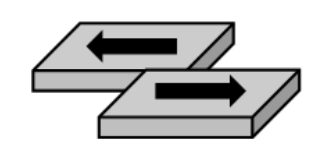 Which BEST explains the type of material Kennedy should use as a model to represent pieces of the Earth's crust in order to illustrate the impact of an earthquake?
Which BEST explains the type of material Kennedy should use as a model to represent pieces of the Earth's crust in order to illustrate the impact of an earthquake?
A. She should use pieces of chalk because they would allow her to see how the Earth's crust chips and cracks as it rubs against itself.
B. She should use two smooth blocks of wood to determine how quickly the blocks would move in an earthquake.
C. She should use blocks of potting soil because they would crumble easily allowing her to see how sediment is carried away by the vibrations and deposited in another location.
A. She should use pieces of chalk because they would allow her to see how the Earth's crust chips and cracks as it rubs against itself.
Two students listed some traits of their favorite football player.
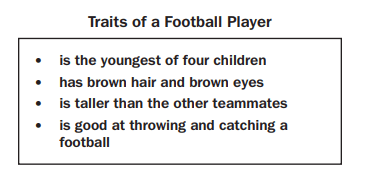
Which question would help the student determine which trait on the list is an acquired physical trait of the football player?
A. How tall is the football player?
B. Does the football player have any siblings?
C. Why does the football player have brown eyes and hair?
D. Has the football player always been good at catching a football?
D. Has the football player always been good at catching a football?
A teacher challenges her students to find a sample of a plant or animal cell and provide an explanation to support their choice. A student submits this cell picture with the required explanation
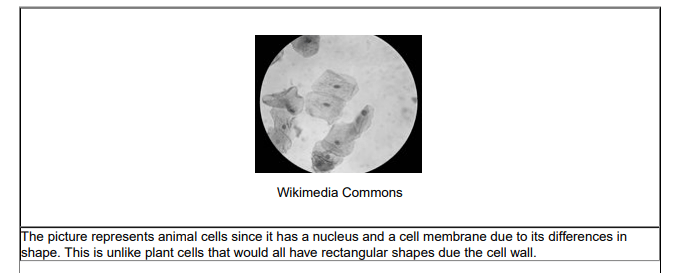
Does the student successfully complete the task assigned by the teacher?
A. Yes, the student correctly identifies that only animal cells will have a nucleus present.
B. Yes, the student correctly identifies the differences in the shapes of plant and animal cells due to the cell wall.
C. No, the student misidentified the cells as animal cells because they have a cell membrane and a nucleus.
B. Yes, the student correctly identifies the differences in the shapes of plant and animal cells due to the cell wall.
The diagram shows a circuit that a student creates for her science class. She uses a battery and a rope connected to a light bulb.
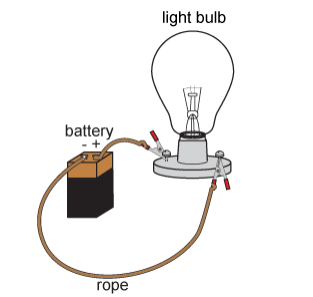
Her classmates predict that the light bulb will not light up.
What is most likely the reason for their prediction?
A. The battery is too large.
B. The power source is missing.
C. The rope will not conduct electricity.
D. The switch is missing from the circuit.
C. The rope will not conduct electricity.
Read the passage about Kimora and Mateo making cookies.
Kimora and Mateo add eggs, flour, salt, baking soda, sugar, butter, vanilla, and chocolate chips into a bowl. Mateo mixes the batter because his favorite part of making cookies is licking the cookie batter off of the mixing spoon. When he is finished, Kimora forms the batter into little balls on the cookie sheet. She puts the cookies in the oven to bake for twelve minutes. After the time is up, Mateo pulls the cookies from the oven and allows them to cool. Kimora eats four cookies and Mateo eats two. They are delicious!
A couple of hours later, Mateo's stomach starts to hurt. He feels nauseous and dizzy. He is sick for three days after eating the cookies.
Which argument best describes a possible explanation of why Mateo got sick but Kimora did not?
A. Mateo ate fewer cookies.
B. Kimora ate more cookies.
C. There were helpful bacteria in the uncooked batter.
D. There were harmful bacteria in the uncooked batter
D. There were harmful bacteria in the uncooked batter
A student wants to design a complete, simple circuit for a class project. The student has more materials available than are needed for the project.
What does a complete, simple circuit require to work?
A. wire and a switch
B. wire and a light bulb
C. wire, a battery, and a switch
D. wire, a battery, and a light bulb
D. wire, a battery, and a light bulb
Zakeria was studying Mount Saint Helens, one of the active volcanoes found in the United States. Based on her research, she claims that this volcano was created by a constructive process.
Which pieces of evidence BEST support Zakeria's claim?
Select ALL that apply.
A. Steam seeps out of cracks in the lava dome as pressure is released.
B. Each time magma reaches the surface of the mountain a new lava dome is created.
C. Mount Saint Helens erupted in 1980 causing the northern face of the mountain to collapse.
D. Mount Saint Helens is composed of lava rock layered with ash, pumice, and other deposits.
B. Correct Answer; The student understands how to support an argument with scientific evidence and understands that constructive forces build up the surface of the Earth to create new landforms. The student understands that the cooling of magma at the surface of the volcano results in the buildup of new rock and increases the size of the volcano.
D. Correct Answer; The student understands how to support an argument with specific evidence and understands that constructive forces buildup the surface of the Earth to create new landforms. The student understands that the presence of layers within the landform indicate the buildup of materials over time by deposition and cooling lava.
The picture shows a cow.
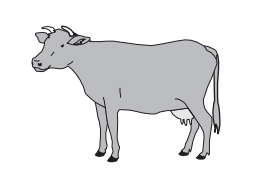
Which question can be asked to learn about the inherited physical traits of the cow?
A. How old is the cow?
B. Has the cow been fed today?
C. Is the cow tame enough to pet?
D. Why does the cow have brown fur?
D. Why does the cow have brown fur?
A student observes some moss growing on the sidewalk. The student collects a sample of the moss and views it under a microscope, as shown in the pictures.
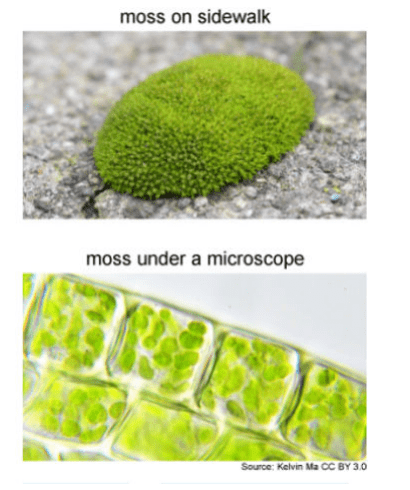
Which claim is best supported by the student's observation?
A. The student can learn more about the cells of the moss using a microscope because cells are only visible when they are magnified.
B. The student can learn more about the cells of the moss by observing it on the sidewalk because cells are only found in living plants.
C. The student can learn more about the cells of the moss using a microscope because the entire plant is able to be viewed at one time.
D. The student can learn more about the cells of the moss by observing it on the sidewalk because cells are only visible as part of the whole plant.
A. The student can learn more about the cells of the moss using a microscope because cells are only visible when they are magnified.
Jamie replaced the switch in an electrical circuit with different items supplying power to a light bulb to see if the current would still travel to the light bulb. She recorded her findings in a chart.
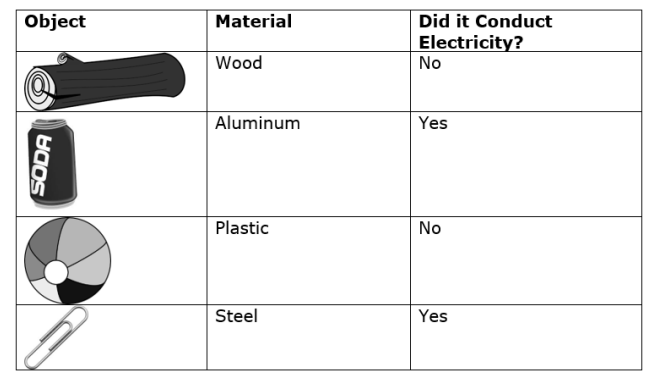
Which statement BEST explains what Jamie discovered about conductors and insulators in her experiment?
A. The objects made of steel and aluminum are insulators because they were able to conduct electricity in the experiments.
B. The objects made of steel and aluminum are conductors because they were able to conduct electricity in the experiments.
C. The objects made of plastic and wood are insulators because they can insulate the electricity and keep it flowing through them.
B. Correct Answer; The student understands that the steel and aluminum objects were conductors because they allowed the electricity to flow through the objects.
Julie mixed together substance A and substance B. She made a list of the evidence she observed when mixing the items together.

Which of the following statements BEST explains the evidence that Julie used to conclude that a chemical change has occurred?
A. When she mixed the substances together, bubbles were created that indicated a gas had been created. The creation of a gas indicated a chemical change had occurred.
B. When she mixed the substances together, the substance did not give off an odor. The lack of an odor from the new substance indicated that a chemical change had occurred.
C. When she mixed the substances together, the new substance did not give off heat. This indicates there was not a physical change, so there had to be a chemical change that had occurred.
A. When she mixed the substances together, bubbles were created that indicated a gas had been created. The creation of a gas indicated a chemical change had occurred.
A student is investigating chemical changes by using different materials. Which investigation would provide evidence of a chemical change and why?
A. Melting a solid with fire would provide evidence of a chemical change because the solid would change shape.
B. Cutting cardboard into many smaller pieces would provide evidence of a chemical change because the pieces cannot be put back together.
C. Placing a solid into hot water and stirring while the solid dissolves would provide evidence of a chemical change because the dissolved material is lost.
D. Combining two liquids that give off heat and gas would provide evidence of a chemical change because the particles react to make a new material with different properties
D. Combining two liquids that give off heat and gas would provide evidence of a chemical change because the particles react to make a new material with different properties
The image shows a flood depth map of New Orleans, Louisiana
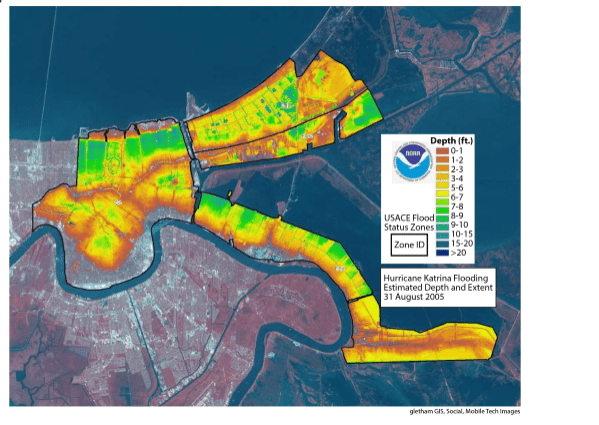
Which question can be studied using this information?
A. In what season do floods normally occur?
B. How much rainfall can cause a flood to occur?
C. Which areas are most likely to flood in the future?
C. The map shows estimated flood depth data for New Orleans to predict and limit the amount of damage caused by flooding
The diagram shows a model that a student is creating to classify plants.
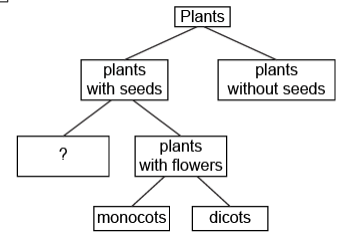
Which missing property should the student add to complete his model?
A. plants with roots
B. plants with cones
C. plants with stems
D. plants with leaves
B. plants with cones
The pictures show a cheetah and a cactus plant

Though these are two very different organisms, how are the cells of these two organisms similar?
A. They both are single-celled.
B. They both contain a cell wall.
C. They both contain chloroplasts.
D. They both contain a nucleus.
D. They both contain a nucleus.
Cammie wanted to know if the south pole of a magnet is stronger than the north pole of a magnet. The student collected three bar magnets and placed them on a sheet of glass with the south poles facing down.

Using what you know about magnets, predict what will happen to block of iron when she flips the magnets over so the north poles are facing down?
A. The iron block will stick to the magnet labeled A, but will not stick to the magnets labeled B and C.
B. The iron block will not stick to any of the magnets because the block is only attracted to the south pole.
C. The iron block will stick to the magnets labeled A and B, but will not stick to the magnet labeled C.
C. The iron block will stick to the magnets labeled A and B, but will not stick to the magnet labeled C.
Nena's mom bought orange juice with pulp, but Nena does not like pulp in her juice. Before drinking the juice, Nena uses a sieve to filter the pulp from the juice. The picture shows how Nena removed the pulp from the juice.
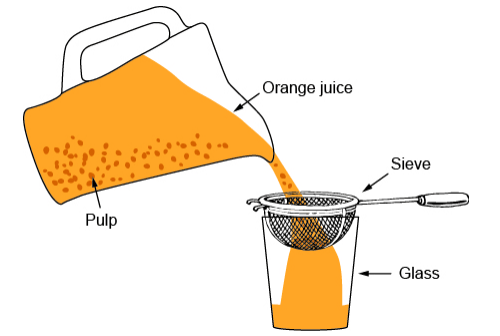
Which statement best describes what Nena did?
A. Nena created two new substances, which is a chemical change.
B. Nena created two new substances, which is a physical change.
C. Nena separated a mixture, which is a chemical change.
D. Nena separated a mixture, which is a physical change.
D. Nena separated a mixture, which is a physical change.
What should you do once you finish your science assessment?
Go back to check your answers
Make sure you answered all questions
During spring break, Julian's family visited Providence Canyon in Georgia, and Peggy's family visited the Grand Canyon in Arizona. Both students brought back pictures of their vacation to share with the class.
 Peggy claims that the steep walls of both canyons were formed by the same destructive process. However, Julian claims that the steep walls of Providence Canyon were created by a constructive process, whereas the steep walls of the Grand Canyon were created by a destructive process.
Peggy claims that the steep walls of both canyons were formed by the same destructive process. However, Julian claims that the steep walls of Providence Canyon were created by a constructive process, whereas the steep walls of the Grand Canyon were created by a destructive process.
Which argument BEST explains which students' claim is correct or incorrect?
A. Julian's claim is incorrect because both pictures show swiftly moving rivers at the floor of each canyon. The moving water weathered away the rock and carried away the sediment over long periods of time creating steep walls.
B. Julian's claim is correct because the picture of Providence Canyon does not have a river at the floor of the canyon to carry away rocks and other sediment. The steep walls were created by a buildup of rock and sand deposited by wind over long periods of time.
C. Peggy's claim is correct because both pictures show steep walls that have been weathered away by water over long periods of time. There is a river at the floor of the Grand Canyon, and the sediment on the floor of Providence Canyon indicates that a creek forms during periods of heavy rain.
C. Peggy's claim is correct because both pictures show steep walls that have been weathered away by water over long periods of time. There is a river at the floor of the Grand Canyon, and the sediment on the floor of Providence Canyon indicates that a creek forms during periods of heavy rain.
A student is designing a model to classify organisms. The diagram shows her incomplete model.
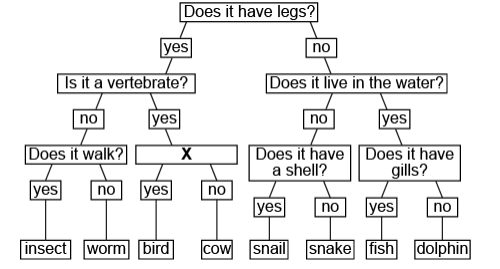
Which TWO questions can the student add to point X on her model that will correctly complete the model?
A. Does it fly?
B. Does it eat?
C. Does it lay eggs?
D. Does it have two eyes? E. Does it breathe with lungs?
A. Does it fly?
C. Does it lay eggs?
Four students created cell models
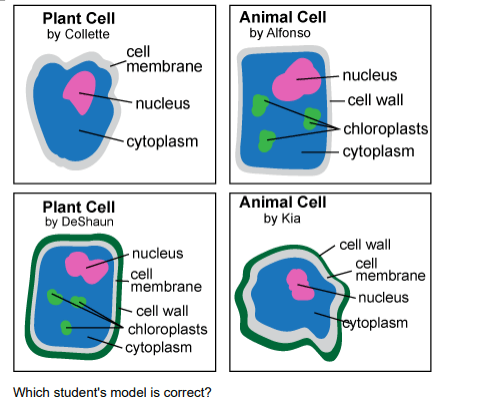
Which student's model is correct?
A. Collette
B. Alfonso
C. DeShaun
D. Kia
C. DeShaun
Madison did an experiment to learn about electromagnets and permanent magnets. She used a nail wrapped with a copper wire attached to a battery. She also used a long bar magnet.
To test the strength of the two magnets she tried to pick up steel paper clips to form a chain.

Madison found that both magnets could pick up 5 paper clips, but if she changed the number of times the wire was wrapped around the nail she could change how many paper clips were in the chain picked up by the electromagnet. Increasing the number of times the wire was wrapped around the nail increased the number of paper clips the electromagnet could pick up. The permanent magnet always picked up 5 paper clips.
Which argument is BEST supported by the information from Madison's experiment?
A. The strength of the permanent magnet is the strongest because it always picks up 5 paper clips in a chain.
B. The strength of the electromagnet is strongest when Madison increases the number of times she wraps the wire around the nail.
B. The strength of the electromagnet is strongest when Madison increases the number of times she wraps the wire around the nail.
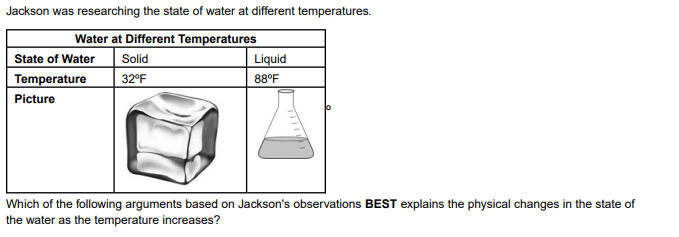
A. The small particles that make up the water slow down or stop moving causing the solid to become a liquid.
B. The small particles that make up the water multiply causing the state of the water to change by increasing the amount of water.
C. The number of small particles that make up the water decrease causing the state of the water and the shape of the water to change.
D. The small particles that make up the water begin to move at a faster rate changing the state of the water and causing the shape of the water to be changed as the particles move.
D. Correct Answer; The student understands that the increase in temperature causes particles to move at a faster rate resulting in a physical change in the water.
A student performs four investigations as shown
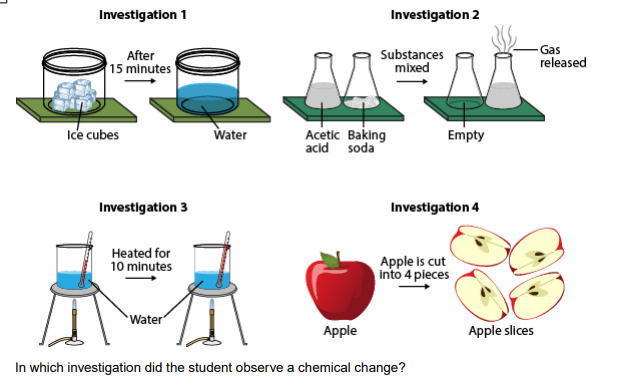
In which investigation did the student observe a chemical change?
A. Investigation 1, because there was a phase change
B. Investigation 2, because a new substance was formed
C. Investigation 3, because there was a temperature change
B. The combination of the acetic acid and baking soda resulted in a gas being formed and released. This is evidence of a chemical change